
Facebook Twitter Instagram YouTube RSS Feed
Written on: December 4th, 2018 in Outreach
by Brittany Haywood, Wetland Monitoring & Assessment Program
Working in wetlands takes a certain breed of people, the kind that has to have a sense of humor. You have to deal with interesting smells, sticky conditions, and bugs that manage to find their way into unwanted places (such as your eye or nose). But if you can handle the not so pleasant parts you will find some of the most amazing views, plants, animals, and people, and that is why we do what we do.
For example, did you know that frogs during the winter use high concentrations of glucose (simple sugar) as a sort of “antifreeze” in their organs to keep them alive while parts of their body become frozen? Or did you know that some species of sphagnum moss can hold 20 times their weight in water? These are just some of the tidbits that we learned as we did our work in 2018.
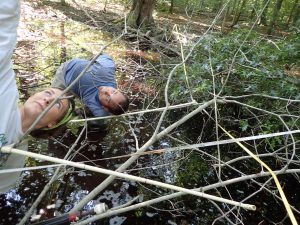
Yoga Instructor: Erin and Kenny in the Assessing Tree Canopy position. This particular position was used during the wetland mitigation/restoration assessment project.
As wetland scientists in our program (DNREC’s Wetland Monitoring and Assessment Program (WMAP)), we learn and work in multiple areas and across the entire State of Delaware. Besides hosting this blog, we bring the science to K-12 students with hands-on classroom learning, to scientists, engineers, and other state workers in the form of professional development opportunities, and to the general public by posting all of what we do and learn to the great world wide web. We do all of these things through our research on wetland health and on innovative restoration techniques.
As we close out the year, we like to provide a general summary of some of the things we have accomplished throughout 2018. We also have provided a few behind the scenes photos that might just experiment with possible alternate career paths for us wetland workers. So keep scrolling and enjoy the view.
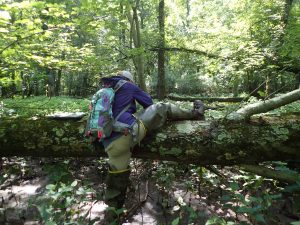
Children’s Books: Brittany is going on a wetland hunt, she’s going to catch a big one. She’s not scared. She can’t go over it? …
Assisted with the development of the Delaware Living Shorelines Website, DNREC Perspectives: Wetlands Wildly Beneficial website and Wetlands Work website
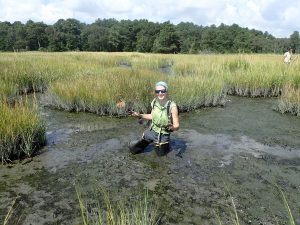
Hollywood Actor: Erin tries her hand at acting out the escape from the sinkhole in the Fire Swamp. Or is she acting?
Held the 2018 Delaware Wetlands Conference
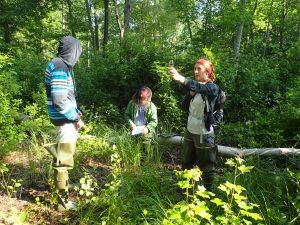
Meditation Guru: Kenny, Erin and Alex ponder the meaning of life and wetlands while trying to block out the mosquito distractions.
Thanks for joining us for the 2018 calendar year as we trekked through wetlands across the state, and we hope to see you in 2019! We would also like to thank all of the partners that have made our work possible. If you have any questions for us, you can get in touch with me at Brittany.Haywood@delaware.gov. Happy Holidays, and have a Happy New Year!
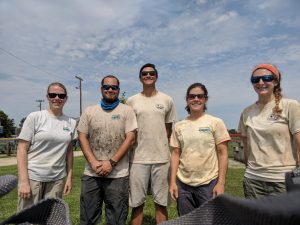
Naw, we’ll keep our own jobs. 2018 staff listed left to right: Brittany, Kenny, Alex (Seasonal), Alison, and Erin
Written on: December 3rd, 2018 in Wetland Assessments
Guest Writer: LeeAnn Haaf, Partnership for the Delaware Estuary
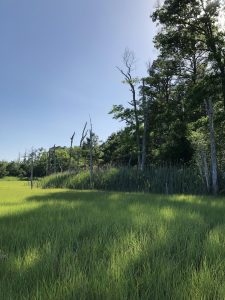
Figure 1. In the Delaware Estuary, there’s still a number of places where forests border tidal marshes, like this example from NJ.
Sea levels are rising in the Delaware Estuary– we’ve already observed its effects. Over the last couple decades, we have seen dramatic losses of tidal marsh acreage and documented the death of trees bordering those tidal marshes. We know that the last hope for a lot of marsh might be their migration upslope into forests. We suspect, however, that the forest might have to give way first.
At only a few millimeters a year, the small changes caused by sea level rise are difficult to see, especially in forests. How do we study those small changes? Luckily, trees still surviving along the tidal marsh edge have been recording environmental conditions since they were saplings (Figure 1). We can learn from the past.
Trees in our area grow wood in rings every year. In the spring, this wood is light and as fall approaches, the wood becomes darker before the tree stops growing for the winter (Figure 2). In good years, the tree might grow more. Likewise, in bad years, the tree might grow only a little, or not at all. Finding patterns of bad growth years allows us to figure out what events caused the trees to grow less– perhaps because it was a drought, maybe insects were eating too many of their leaves, or perhaps there was a big storm that flooded the forest with salty water.
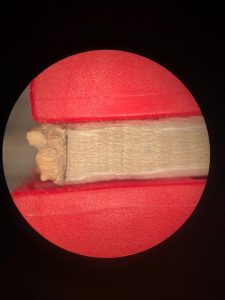
Figure 2. Growth rings in an American holly– on the left is bark separating the not finished 2018 growth ring. Can you spot which ring was laid 2013, after Hurricane Sandy?
If certain forests get flooded with a lot with salt water, and trees grow less because of it, they will not be as quick to recover from future floods. Groundwater and soil moisture will change. This means that the forest, and the types of trees in it, will also change.
Sensitive trees will die off first, then only certain trees will remain. Eventually, the margin of the forest will contain no living trees and the soils will be wet enough for marsh grasses to move in. Bad news for the forest, but great news for the marsh! My research focuses on developing an understanding of how trees adjust to coastal hazards (like storm surge or sea level rise) and what this might mean for the future of these forests (and the marsh!).
To study growth patterns in trees, a very small, narrow core is extracted from each study tree (Figure 3). So far, I have studied pitch pines (Pinus rigida) and American hollies (Ilex opaca), both of which are common near tidal marshes (elevations that are less than 3 m or 3.3 yd above sea level).
In the near future, I’ll expand these studies to red cedars (Juniperus virginiana) and maybe loblolly pines (Pinus taeda). I’m using x-ray fluorescence to help identify chemical elements that have been stored in the wood to pinpoint changes the trees may have experienced over time. Since salt water has unique chemicals compared to freshwater, we can get a sense if salt water flooding has become a more regular event through the tree’s life.
The most major flooding event in the last decade was undoubtedly Hurricane Sandy, which made landfall in NJ at the end of October 2012. In the Delaware Estuary surge tides peaked well over 2.5 meters (2.7 yards) for two consecutive days. Many of the trees I’ve been studying grew less in 2013, the year after Hurricane Sandy. This seems perplexing, but the hurricane hit at the very end of the growing season. The salt water flooding likely impacted the soil into 2013, so that trees struggled most the summer following the Hurricane.
I also see less or no growth in 1996. This year was actually one of the wettest years on record, and in other nearby locations, trees did remarkably well. Could too much rain in 1996 have led to overly wet soil in these low lying forests? I’ll be studying this more to see if there’s a coastal-connection.
Data from x-ray tests show trees can manage chemicals in their living tissues, and sometimes, whether conditions were good for uptake of micronutrients, like iron, calcium, and sulfur. When a forest floods with sea water, it introduces different components to the soil. This process can lead to an increase in the availability of iron, because of the extra moisture, as well as sulfur.
So far, I’ve tested four different trees using x-rays that varied from 4 to 34 meters from the marsh edge. Although these chemicals change from year to year, trees closer to the marsh seem to have consistently more iron and sulfur in their wood, but haven’t been growing any more or less than the other trees relative to their sizes. I’ll need more data to see if this patterns can be found in other trees, in other areas.
Although the overall short term prognosis of low lying coastal forests is still hazy, we’re working to better understanding the impacts of salt water flooding and sea level rise. So far, it looks like the changes to forest ecology caused by sea level rise are subtle. Trees can withstand quite a bit of environmental stress and are pretty resilient to change. It may take a couple decades to see more noticeable forest loss caused by sea level rise, but the impacts of storm surge could be more destructive and more immediate.
In general, forested areas may become wetter or swampier as sea levels rise, without very noticeable rates of tree stress or death caused by salt water. But if storm events bring and hold a lot of salty water in specific forests, we might see a lot of tree death in a short amount of time at that location (but maybe not others). If we cross walk both scenarios, we might see that forest loss and conversion into marsh will first happen mostly sporadically, starting where forests are most vulnerable to storm surge, then the marsh will slowly creep upslope where it can as sea level rises.
For more information about this project, please contact LeeAnne at lhaaf@delawareestuary.org.
Written on: December 1st, 2018 in Wetland Animals
by Kenny Smith, Wetland Monitoring and Assessment Program
Wetlands provide many services to us, like purifying our water, flood protection, and wildlife habitat. The animals that live in our wetlands can provide ample opportunities for outdoor activities like bird watching, fishing, and hunting. Delaware’s typical hunting and trapping seasons start in September and concludes at the end of January. Some of these species are migrants and pass through our wetlands on their way to wintering or breeding grounds, but most of these species are year round residents.
Continue on to learn about some of the hunting and trapping that you can do in the wetlands of Delaware and potentially partake if these opportunities seem interesting to you.
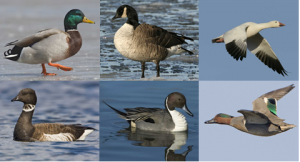
From left to right, top to bottom: Mallard, Canada Goose, Snow Goose, Brant, Pintail, Green-winged Teal Photo Credit: Audubon
Starting with the most common hunting activity in our wetlands is waterfowl hunting, this consists of ducks, Canada geese, snow geese, and brant. These species use a diverse array of wetlands in the state from tidal wetlands to wooded depression wetlands. Wood ducks prefer non tidal wooded wetlands where they can nest in tree cavities, while snow geese will roost along tidal wetlands on their way to wintering areas.
Most of the waterfowl hunting in Delaware is focused on the winter migrations of these birds, they leave the arctic breeding grounds and fly through Delaware on the way to wintering grounds in the southern U.S.
Based on Delaware Fish and Wildlife mail surveys, the estimated harvest of ducks last year was just over 40,000 while Canada geese harvest was about 20,000, and snow geese was 11,000. This survey estimates that around 5,000 people enjoy waterfowl hunting in the states wetlands every year.
Muskrat are a year round resident of tidal salt marshes throughout the state, they create small mounds in salt marshes where they live. Muskrat are members of the rodent family but are actually omnivores and will consume vegetation but also frogs and fish.
They are one of the more common species to be trapped in Delaware and have been a Delaware tradition since colonization, with the meat and fur being the objective. The furs are sought after for clothing manufacturing, mostly in China, Russia, and Korea now that the North American fur demand has decreased significantly.
The meat from muskrat is a local delicacy and is often sold to local restaurants, local wild game dinners, or consumed by the trapper. If you are daring, some Delaware restaurants still serve muskrat and it can still be found at local butcher shops.
The non-waterfowl gamebirds I am referring to are the rails, snipe, coot, and the gallinules and moorhens. Most of these birds migrate through Delaware, with rails being the exception being year round residents.
Rails are a secretive marsh bird that inhabits our tidal salt marshes, with 4 different species being the target of sportsmen. The clapper rail is the most common rail found in Delaware, with the sora, the Virginia rail, and the King rail being the least common. Snipe are the next bird that hunters can target, and this is not a childhood prank. Snipe are actually a very common bird that hunters pursue. These birds usually can be found around open marshes and mud flats of our coastal wetlands. In the Delaware Fish and Wildlife mail surveys, they estimated that almost 400 rail and about 40 snipe were hunted last year.
Coots, gallinules, and moorhens are not as regional hunted as they are in other parts of the country but we do have them and they legally can be harvested. Coots can be found along marsh edges and can create large flocks on open water while moorhens and gallinules are more solitary and can be found along edges of marshes or ponds similar to rails.
Bullfrog and Snapping turtles are year round residents and can be found in many of our freshwater wetlands throughout the state. Bullfrog hunting is slightly different from any other hunting that happens in wetlands, you are allowed to do it at night, you don’t use a trap or gun, and the frog season runs from May 1st to September 30th. Instead you can use a light at night in the warmer months and hunt frogs with a spear or gig. Bullfrog hunting is very common in the southern U.S., and is still practiced by many in the Delmarva region. Bullfrog hunting can be a very inexpensive hunting endeavor since only a light and gig are required once you have the proper license.
On the flip side snapping turtle trapping is a very labor intensive adventure and you will need a lot more equipment. You can still try and use a spear, gig, or net but it is usually not as successful as using traps. The snapping turtle season runs from June 15th to May 15th and each turtle has to be a minimum of 11 inches on the curvature of the top shell. Bullfrog and snapping turtle are the 2 most common herpetological prey for hunters to pursue and are abundant throughout the state.
Highlighted were just some of the opportunities to hunt or trap in the wetlands of Delaware, check the Delaware Hunting guide for the proper seasons and laws before partaking in these activities. You will need to purchase a hunting or trapping license and tag along with a friend or family member and enjoy the outdoors. Below are some online resources to help you if you would like to try hunting or trapping in Delaware.
Written on: December 1st, 2018 in Wetland Animals
by Erin Dorset, Wetland Monitoring & Assessment Program
In the spring and summertime, Delaware’s wetlands are teeming with wildlife. Frogs and toads are heard in chorus, calling for mates; turtles are observed slowly walking through the woods or basking on logs and rocks in the water; snakes are seen slithering across mosses or trees. But by late fall, many of these fascinating creatures seemingly disappear, making winter wetlands seem relatively quiet and still. Have you ever wondered where the reptiles and amphibians go when the days get short and cold, and how they survive freezing temperatures?
In the winter, many of these wetland animals undergo a process known as brumation. During brumation, animals will substantially lower their heart rates, activity levels, body temperatures, and metabolisms. Because their energy demands become so low in this state, they do not eat and barely breathe at all! However, some animals in brumation may still show some movement, particularly during warmer spells. This is why they are said to brumate, not hibernate, as hibernating animals typically do not wake or move around in the middle of their sleeping period. The place where they spend the winter is called a hibernaculum.
Many of these wetland creatures handle brumation a bit differently—read on to find out more!
Delaware’s wetlands are home to many aquatic turtles, such as the Northern diamond-backed terrapin (Malaclemys terrapin terrapin) and the Eastern painted turtle (Chrysemys picta picta), as well as many terrestrial turtles, such as the Eastern box turtle (Terrapene carolina carolina) and the spotted turtle (Clemmys guttata). As winter approaches, aquatic turtles usually bury themselves in mud or under banks of water bodies to brumate, while terrestrial turtles typically go underground in burrows.
Hatchlings of some species may spend the winter within the nest where they were born. Because they are often under water or fully buried, they are unable to get a lot of oxygen. The oxygen the turtles do need comes from the few breaths they do take as well as from stored energy within their bodies. Unfortunately, this breakdown of stored energy without much oxygen can create harmful compounds within the body, such as lactic acid. Some turtles, though, such as Eastern painted turtles, have the really cool ability to neutralize the acid using the calcium carbonate in their shells¹!
Because turtles usually bury themselves, they are often able to escape contact with snow and ice. However, sometimes ice crystals can form in their overwintering spaces, creating a heightened risk of freezing. Turtles have an awesome way of dealing with this. Some species, such as the diamond-backed terrapin, are freeze-tolerant, meaning that they can still live for a certain amount of time even if some of their body fluids have frozen.
Other species use a strategy known as supercooling, where body fluids remain unfrozen up to a certain point even when the temperature has dropped below the freezing point². Once the days start to get longer and the temperature is consistently higher, the light and warmth act like biological alarm clocks; the turtles will know that spring has sprung and that it’s time to come out.
Much like turtles, frog species that spend a lot of their time in water, such as the Southern leopard frog (Rana sphenocephala utricularia) and the American bullfrog (Rana catesbeiana), will overwinter underwater. These frogs live off of extra energy stores within their bodies that they built up specifically for the winter months.
However, unlike turtles, frogs cannot bury themselves completely under the mud; rather, they can only bury themselves partially. With their skin exposed above mud, frogs can often get all of the oxygen they need to survive the winter through their skin!
When dissolved oxygen levels in the water drop, overwintering frogs are faced with a serious challenge, as they cannot survive more than a few days without the right amount of oxygen present. If such a challenge occurs, some frogs have the capability of sensing it and can undergo what is called behavioral hypothermia. In other words, the frogs will actually move to colder water in order to further lower their metabolism, which ends up increasing the amount of oxygen in their blood to keep them alive longer. But, if there is plenty of oxygen in the water, the frogs can actually move to a nearby spot with relatively warmer water³.
Terrestrial or land loving frogs have a different strategy to deal with winter. They will find a damp area in underground burrows, under leaf litter, or in deep crevices to escape freezing temperatures and frost.
Some frog species may actually overwinter at shallower depths than others; species that do this, such as the wood frog (Rana sylvatica), can tolerate freezing. These frogs use high concentrations of glucose (simple sugar) as a sort of “antifreeze” in their organs to keep them alive while parts of their body become frozen. Because of this, they can stay alive even while partially frozen with no breathing or heartbeat4! Once temperatures warm up, their heartbeat and breathing return to normal.
Many different snake species can be found in and around Delaware’s wetlands, including the common ribbonsnake (Thamnophis sauritus sauritus), Eastern ratsnake (Elaphe alleghaniensis), Northern black racer (Coluber constrictor constrictor), and Eastern gartersnake (Thamnophis sirtalis sirtalis).
To escape the cold, these snakes overwinter in sheltered places such as burrows, rock crevices, and wood piles. Interestingly, many snakes will brumate in the same place each year, and often, they are not alone. It is common for snakes to spend the winter in a hibernaculum with other snakes, either of the same species or multiple different species.
Although the snakes may move a bit and drink a little water, they mostly remain within the hibernaculum with a slowed heartbeat and metabolism and no food until the weather is consistently warmer. Within their hibernaculum, though, some snakes may move around to relatively warmer spots to help increase their body temperature5.
¹Jackson, D. C. 2000. Living without oxygen: lessons from the freshwater turtle. Comparative Biochemistry and Physiology Part A, 125: 299-315.
²Baker, P. J., Costanzo, J. P., Herlands, R., Wood, R. C., and R. E. Lee, Jr. 2006. Inoculative freezing promotes winter survival in hatchling diamondback terrapin, Malaclemys terrapin. Canadian Journal of Zoology, 84: 116-124.
³Tattersall, G. J. and G. R. Ultsch. 2008. Physiological Ecology of Aquatic Overwintering in Ranid Frogs. Biological Reviews, 83: 119-140.
4Storey, K. B. and J. M. Storey. 1984. Biochemical adaptation for freezing tolerance in the wood frog, Rana sylvatica. Journal of Comparative Physiology B, 155: 29-36.
5Macartney, J. M., Larsen, K. W., and P. T. Gregory. 1989. Body temperatures and movements of hibernating snakes (Crotalus and Thamnophis) and thermal gradients of natural hibernacula. Canadian Journal of Zoology, 67: 108-114.
Written on: December 1st, 2018 in Wetland Animals
Guest Writer: William Koth, Delaware State Parks
Bryozoans may be one of our most overlooked and underappreciated animals. Known as “Moss Animals,” bryozoans are small, simple animals rarely growing more than 1/25th of an inch in length. However, most bryozoans form colonies that can vary greatly in number, form, and size.
Each individual animal, or zooid, has a simple body style, usually round or oval in shape with a single opening that serves as both a mouth and an anus. Bryozoans lack any respiratory, excretory,or circulatory systems, but have a central nerve ganglion that allows the animal to respond to stimuli. They feed using small tiny ciliated (hair-like) tentacles that the surround the opening and push food through the it into the gut. In some species, and during certain life periods, these tentacles can be used for simple movement. Most species, however, spend the majority or all of their lifespan immobile.
The vast majority of Bryozoan species are marine animals. Of nearly 5,000 species, less than 90 have been identified in freshwater environments, and only 24 freshwater species in North America (so far).
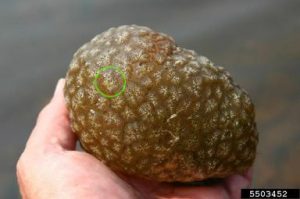
The green circle highlights a rosette or colony of bryozoans. Photo credit: Leslie J. Mehrhoff (bugwood.org)
In the freshwaters of Delaware, you are most likely to encounter the native Magnificent Bryozoan (Pectinatella magnifica). This colonial species forms jelly-like “green blobs” on underwater vegetation, branches and other structures. They may also form free floating round colonies. The small visible rosettes on the surface of the colony are groups of 12-18 individual animals.
Although the Magnificent Bryozoan reproduces both sexually and asexually, the main way the colonies form is when the existing individual animal or zooid breaks away or buds asexually forming a twin. As they reproduce, they multiply into an ever growing sphere as the individuals point their mouths outwards to take advantage of available food. Meanwhile, the zooids excrete gelatinous material to give the sphere interior support.
Completely new colonies can also form asexually from small statoblasts (a group of cells encased in a hard covering to protect them from freezing or other harsh conditions). These statoblasts can float in the current, or settle to the bottom where they eventually grow into an individual zooid. These individual zooids can use their ciliated tentacles to move about in the water. They will eventually begin dividing and form a new colony. Smaller free floating colonies have been observed to use the ciliated tentacles in unison to move toward or away from stimuli.
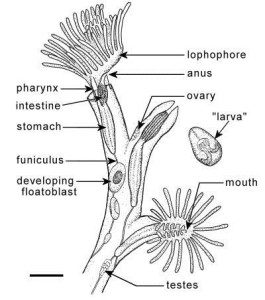
Two bryozoan individuals and their anatomy. Dr. Timothy S. Wood (Department of biological sciences, Wright University)
The Magnificent Bryozoan actively feeds on suspended organic material, zooplankton, and algae. In this way it can be considered a filter feeder and may, in some instances, increase water clarity. Individual animals on the colony are clear or opaque. It is speculated that the green color of the colonies stems from ingested algae.
The Magnificent Bryozoan is native to Delaware, its native range extends from the Mississippi eastward to the Atlantic Coast from Ontario southward to Florida. Invasive outbreaks have been occurring in Europe since the 1930’s and west of the Mississippi since the 1950’s. The ecological impact of these invasions is still being studied, but colonies and groups of colonies have started to block some smaller waterways, ditches, and drainpipes. Colonies have been recorded up to 4 feet in Virginia, although the typical size found in Sussex County swamps, ponds and waterways is an inch to about a foot in diameter.
Encountering a colony of these animals can be a great experience. Trap Pond State Park staff receive several inquiries about these creatures each year. Most folks guess that they are some type of algae or fungus. Other guesses include freshwater jellyfish or fish eggs. Almost everyone is surprised to find out it is actually a colony of animals.
The staff recommend that you take full advantage of discovering one of these unique creatures. They do request that you not dislodge attached colonies, and not to keep them out of the water for more than a few minutes at a time. Lift it up, feel its surface, feel its weight, smell it. If you have a magnifying glass, take a look at the individual zooids on the surface. They are amazing animals that deserve a closer look and a little more appreciation!
Written on: November 27th, 2018 in Wetland Restorations
By Michael Bott, DNREC Watershed Assessment and Management Section
Have you ever wondered why there is so much submerged aquatic vegetation (SAV), also called seagrass, in the tidal waters of Virginia and Maryland but not in Delaware? This is a question many researchers and regulators in the state have been trying to solve and this year has finally given those involved some hope.
Unlike the Chesapeake Bay, the Delaware Bay is a very different ecological system and the naturally turbid waters do not support these large seagrass beds. Delaware’s Inland Bays on the other hand are similar to the Chesapeake and Coastal Bays of Maryland and Virginia and recently there have been some encouraging developments that someday this important ecosystem can flourish in Delaware.
In the Chesapeake Bay, ongoing largescale projects aim to restore and protect large seagrass meadows but historically Delaware’s restoration efforts have been small in comparison.
Just like wetlands provide countless services by purifying water, providing essential habitat and reducing storm impacts; SAV provides many of these same ecosystem benefits to the underwater world. Don’t forget, open water is a wetland too!
Seagrass beds help to stabilize sediments, provide essential nursery habitat to aquatic species and improve recreational fishing and hunting opportunities in the waters where they grow.
As we continue to reduce nutrients such as Nitrogen and Phosphorus from entering our waterways, we should see less of the bad species of algae which covers the bottom blocking sunlight, thus creating more available habitat for SAV.
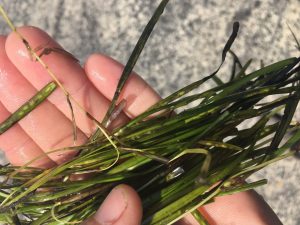
Eelgrass seeds collected in the spring of 2018 used in the restoration of the state’s last known eelgrass bed in the Inland Bays.
When people talk about SAV, the first thing many think of are the iconic eelgrass beds of the lower Chesapeake and Coastal Bays of Maryland and Virginia, but not Delaware. Indian River Bay is home to the only known eelgrass bed in the state. This small bed has been clinging to life for over 15 years, but has been unable to expand its range much on its own.
Over the years, restoration efforts have tried to start small eelgrass beds in other portions of the Inland Bays, but so far these efforts have failed. Instead of trying to do the same exact thing and hoping for different results, the restoration efforts this year focused on trying to increase the size and health of the existing eelgrass bed. The hope is that if the current bed can grow, it will be able to produce enough seeds that could be transported by tides or wind to nearby areas to start new beds.
In the higher salinity marine waters where eelgrass grows you can also find widgeon grass, an equally important species that can be found from coastal bays to roadside ditches. In the lagoons and canals of South Bethany, this species has slowly been taking a foothold in the Inland Bays. It has been known for several years that widgeon grass could be found in these canals at low densities, often near the dead ends and away from boat traffic.
In 2018 the widgeon grass beds exploded which was very exciting for those researchers and regulators mentioned above, but was not viewed with the same enthusiasm by residents who now were dealing with SAV clogging their boat motors instead of algae. This event provided an opportunity for all parties to work together to help educate those who thought this was just another nuisance algae. It was also a great opportunity to use the seed resource to try and establish an SAV bed in nearby Little Assawoman Bay.
If you want to help SAV return to the coastal waters of the State of Delaware, you can do your part in many of the same ways you help protect the more familiar wetlands you see every day. By maintaining healthy wetlands, harmful nutrients and other pollutants are removed before they enter the coastal waters and negatively impact seagrass beds.
It is also important to be mindful when boating in areas where SAV are found because a boat prop can quickly destroy all the hard work put into restoration. Currently a proposed regulation, if adopted, will prohibit clamming in SAV beds which are mapped by the state.
There are also groups working to protect SAV beds in freshwater tidal rivers of the state like the Nanticoke Watershed Alliance, where species such as wild celery and other freshwater vegetation can be found. By joining or supporting your local non-profit environmental organizations such as the Delaware Center for the Inland Bays, the Partnership for the Delaware Estuary or the Nanticoke Watershed Alliance, you can actively show your support for SAV and make sure your voice is heard.
Written on: September 12th, 2018 in Wetland Assessments
by Alex Thomas, Wetland Monitoring & Assessment Program
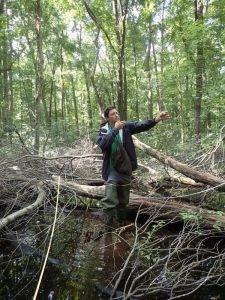 When I got the call telling me that I had been offered the position of Wetland Field Technician for DNREC I was ecstatic. I would be working outside all summer, assisting on legitimate research projects and working with something I absolutely love. What I didn’t know at that time, was that field work comes with some….challenges.
When I got the call telling me that I had been offered the position of Wetland Field Technician for DNREC I was ecstatic. I would be working outside all summer, assisting on legitimate research projects and working with something I absolutely love. What I didn’t know at that time, was that field work comes with some….challenges.
There are some of the obvious ones like heat and thorny plants, however nobody told me that turkeys like to make nests in shrubs and jump out at you screaming bloody murder as you walk right next to them. Having this experience my second day on the job really set the tone for the rest of the summer.
Like I said before heat was an ever present challenge. I can recall one day we were in the Piney Point salt marsh with no shade, and a heat index of 110 degrees. (When you start sweating through your shirt 15 steps from the car, you know it’s going to be a great day.) Not to mention this particular salt marsh is littered with 3 foot holes hidden under tall swathes of Spartina alterniflora. Traversing this maze of hidden holes carrying all of our field equipment was an experience.
I can only imagine what we must have looked like to a random bystander. Seeing a team of scientists, completely drenched in sweat, walking three steps and sinking into hip deep mud with everything but the top of their heads covered by Spartina must have been hilarious to watch. Taking my first steps out of that marsh that day was nothing short of relief. I would also like to formally apologize on behalf of all of us who used the research van that day. We tried our best to keep it clean.
Everyday this past summer was one filled with excitement, even the days we spent primarily in the office. However, there is one day that will stand out above the rest. One day after finishing our last site of the day, Kenny and I were walking out of the woods back to the car to head back to the office. Everything was going smoothly until I felt a sharp pain in the back of my leg.
I immediately told Kenny that I think I walked through some stinging nettle and that he should be careful. A few steps later I feel more sharp pains and I start looking around frantically trying to find out what’s been stinging me. That is until I look at my finger and see a small black and yellow insect sitting there and the sharp pain I felt in the back of my legs starts to spread through my hand.
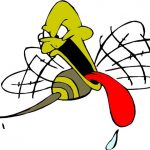 At this point I hear Kenny shout “YELLOWJACKETS!” and we start sprinting through the woods and trampling over patches of greenbrier and hurdling downed tree trunks like Olympic athletes, all the while being chased by a swarm of angry yellow jackets. Once out of the woods we were able to regroup and swat off the remaining bugs. All in all I was stung 17 times and had the pleasure of watching my calves and thighs swell up to almost twice their normal size.
At this point I hear Kenny shout “YELLOWJACKETS!” and we start sprinting through the woods and trampling over patches of greenbrier and hurdling downed tree trunks like Olympic athletes, all the while being chased by a swarm of angry yellow jackets. Once out of the woods we were able to regroup and swat off the remaining bugs. All in all I was stung 17 times and had the pleasure of watching my calves and thighs swell up to almost twice their normal size.
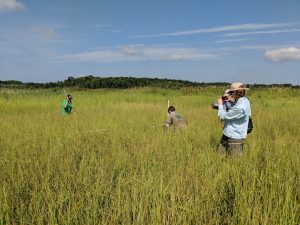 Even though these stories may sound scary or dangerous, I wouldn’t change a single thing that happened to me this summer! Summer 2018 has been a summer to remember. I will never forget the experiences I gained working for DNREC. Not only has this position prepared me for future field work positions, It has opened my eyes to the hard work that goes into assessing and preserving Delaware’s wetland habitats.
Even though these stories may sound scary or dangerous, I wouldn’t change a single thing that happened to me this summer! Summer 2018 has been a summer to remember. I will never forget the experiences I gained working for DNREC. Not only has this position prepared me for future field work positions, It has opened my eyes to the hard work that goes into assessing and preserving Delaware’s wetland habitats.
Lastly I would like to personally thank everybody that I have worked with this summer. This summer wouldn’t have been nearly as exciting or informative if it wasn’t for all of you. Thank you for allowing me to have this experience with all of you, keep up the good work
This post is part of a series of posts titled “Confessions of a Seasonal”, and is written by a summer seasonal worker of DNREC’s Wetland Monitoring & Assessment Program.
Written on: September 12th, 2018 in Outreach
by Mark Biddle, DNREC Watershed Assessment and Management Section
States and tribes across the nation are scrambling to assess how waters are protected within their jurisdiction under the federal Clean Water Act (CWA). Specifically, a recent U.S. District Court ruling to CWA Section 404, which is the federal program that regulates dredge and fill activities in traditionally navigable waters and wetlands, has changed the scope of what is regulated in some states. Additionally, newly proposed legislation in Congress could affect states approval authority under CWA Section 401, which requires any applicant of a federal permit to also get water quality certification based on that state’s water quality standards.
Section 401 Water Quality Certification has long been a successful partnership between federal and state water quality protection programs. Simply, the EPA has given states the ability to set water quality standards for wetlands and surface waters, and with it the authority to add valuable local knowledge through 401 Certification in coordination with federal approvals.
A new bill in Congress was created in reaction to two states holding firm ground in their ability to permit, through Section 401, large and significant energy projects. Since Section 401 gives the states the ability to veto federal government approval in considering how a project may affect a state’s waters, it’s viewed as a hurdle for large energy industry projects that may be beneficial to even more than one state. Proponents of the bill say it closes loopholes ripe for abuse, while opponents see the bill as a removal of state’s rights and the ability of states to have a say in protecting its wetlands and surface waters.
For Section 404, a ruling in mid-August by the South Carolina District Court (Charleston Division) found that the Environmental Protection Agency (EPA) and the Army Corps of Engineers failed to adhere to the Administrative Procedures Act in issuing the ‘Suspension Rule’ in February, 2018. The Suspension Rule was one of the steps taken by EPA and Corps in reaction to the Presidential Executive Order 13778 which set to rescind the 2015 Waters of the United States Rule (WOTUS), and replace it with a new rule. The Suspension Rule set to delay the 2015 WOTUS Rule until 2020 to allow time for creating a replacement. The 2015 Rule was developed to provide more clarity to the Section 404 program and much of it was based on review and recommendations by a Science Advisory Board assembled by EPA. The 2015 Rule received challenges in a few U.S. Circuit Courts leading to a stay of the rule nationwide. This new ruling in the South Carolina District Court puts back in place the 2015 WOTUS Rule for 26 states, including Delaware, while there are still District Court injunctions in place for the other 24 states.
One of the main benefits of the 2015 Rule is that the Science Advisory Board reviewed scientific research that establishes the water ‘system’ connections between flowing surface waters and those adjacent wetlands that may not have a surface connection, but are just as important to downstream water quality within a watershed. In Delaware, we have ecologically unique wetlands known as Delmarva Bays or Coastal Plain ponds. These depression-like wetlands are vitally important to many plant and animal species, some state or globally rare, while also contributing to flood control and water filtration. (I.e. Delmarva Bays are good water quality filters for downstream waters.) There are similar wetlands to Delmarva Bays in other states such as the Prairie Potholes and Carolina Bays which are also included under the 2015 Rule.
There are still many moving parts to where water and wetland protection will end up, most importantly with state’s rights. Recently, the federal government has on one hand reached out to states in the name of cooperative federalism (404), but has also shown the desire to roll back state’s ability to protect its waters and wetlands (401).
In early August, the Corps released a statement encouraging states to assume Section 404 oversight. For the protection of wetlands and clean water, it is imperative to have baseline federal protection of intrastate waters. If water regulation is completely left to each individual state, states downstream from other states may have to deal with another state’s pollution. A baseline federal protection gives states a platform to build upon in protecting sovereign waters and wetlands, and a federal-state partnership in protecting these resources is vital.
For more information please visit epa.gov/wotus-rule.
Written on: September 12th, 2018 in Outreach
by Erin Dorset, Wetland Monitoring & Assessment Program
Wetland plants live a tough life. They are often under water for significant periods of time, meaning that they are frequently deprived of oxygen. Wetland plants also need to remain stable in the soil if they deal with fast moving water that ebbs and flows. Those that live in marine or estuarine areas are under even more stress simply because they need to be able to deal with saltwater! So how are wetland plants able to survive and reproduce under these difficult conditions?
Read on to learn about just a handful of the cool adaptations that some of Delaware’s wetland plants have that allow them to thrive in watery—and sometimes salty—habitats!
If you’ve ever seen a saltmarsh in Delaware, then you’ve probably seen saltmarsh cordgrass. It grows in the areas in saltmarshes that are relatively low in elevation, meaning that they are flooded at every high tide (Figure 1). This plant has to deal with saltwater, and lots of it! It is also what’s known as a halophyte, which is a plant that can tolerate saltwater conditions. This grass actually has salt glands so that it can secrete all of the excess salt out (Figure 2). If you look carefully at its leaves, you can sometimes actually see the salt crystal secretions! Some other saltmarsh plants have this ability too, such as spike saltgrass (Distichlis spicata).
The name of this plant is fitting, because its leaves look like large arrowheads (Figure 3). Arrow arum likes to live in tidal freshwater marshes, lakes, and ponds where the water is shallow. This plant has evolved an interesting and effective way of reproducing while living in the water. The fruits, which look like greenish berries, fall into the water when they are ripe. Once they are in the water, the coating around the fruits swells and eventually bursts. After the coating bursts, the berries are capable of floating on the surface of the water. The berries can then release seeds, which sink to the ground below the water to eventually germinate and grow new plants. Because the berries can float on the water, seeds can disperse for plants to grow in new areas. Arrow arum knows how to work with the water!
Bald cypress trees are deciduous conifers that grow in swamps and in floodplains along rivers and streams. They are southern trees, so Delaware is the farthest north that they grow naturally! How is it that a big tree can withstand so much water? Well, bald cypress trees have specialized root structures called pneumatophores—commonly called “knees”—that grow vertically out of the ground and water (Figure 4). Scientists believe that these knees help get air to roots that are under water. They might also help stabilize the tree in very watery conditions. A great place to go see bald cypress trees and their cool wetland adaptations in Delaware is Trap Pond State Park!
Cattails are one of the most well-known wetland plants because they are widespread and easily recognizable with their brown, “tail-like” flowering structures (Figure 5). There are two species of cattail in Delaware; the broadleaf cattail is native (Typha latifolia), while the narrowleaf cattail (Typha angustifolia) is invasive. Both species are commonly found in marshes, shallow ponds, ditches, and wet meadows.
These areas often have standing water, and cattails have evolved a way to cope with that. Cattails have something called aerenchyma in their leaves, stems, and roots. Aerenchyma are basically open spaces that allow oxygen to travel from the air, to the leaves and shoots, and down to the roots and rhizomes (underground root-like stems) that are underwater. This keeps the parts of the plant that are submerged happy! They also help keep cattails upright in water because they keep the leaves fairly stiff. If you cut a cattail leaf open, you can actually see the aerenchyma in the leaves! Many other herbaceous wetland plants share this same adaptation to survive in wetland environments.
Next time you’re near a wetland, notice the plants and get curious about all of the amazing ways that they have adapted to live in watery conditions. After all, not just any plant can do it!
Written on: September 12th, 2018 in Wetland Assessments
Guest Writer: Nicole Rodi, Delaware Coastal Programs
Ahh the average morning routine- drinking some coffee, making lunch, brushing your teeth, and washing your face- unknowingly rubbing tiny pieces of plastic on your face, and teeth!
Fortunately, due to the Microbead Free Waters Act there is a ban on microbeads in tooth paste and facewash, but the sink drain is not the only way microplastics get into the environment (Pallone, 2015). The microbeads that USED to be found in products like this are just one form of microplastic.
A microplastic is defined by NOAA as a piece of plastic smaller than 5mm (Roles, n.d). Microplastics come in all forms. Sometimes they enter the environment already small, such as a microbeads or microfibers, but often they enter the environment through the degradation of large pieces of plastics like water bottles and balloons.
Plastic does not biodegrade once it enters the environment, however, over years of sun and water exposure it will photodegrade into smaller and smaller pieces that likely never disappear, and only get smaller. The lightweight nature of plastic means it can be easily carried by wind and water, meaning when litter is thrown out the window in a city in the middle of the country it will most likely find its way to the ocean.
Scientists are now starting to study microplastics and their movement within the ecosystem, as well as their impacts to wildlife and habitats. Through these studies scientist have discovered that microplastics are being ingested by the smallest of organisms, zooplanktons, which are arguably the building block of the entire ocean food web (Cole et. al, 2013).
The Delaware Coastal Programs (DCP) is delving into the issue to develop baseline data and information about the abundance and locations of microplastics in the state. Through research on microplastic identification methodologies and quantification DCP hopes to discover the fate of these microplastics and where they are building up in our ecosystem. Identifying the sources and sinks of microplastics is the first step in tackling the issue.
The DCP study started with sand collection on three beaches of Kent County, Delaware and has expanded to water and sediment samples in the St. Jones estuary. The initial phase of the study is developing guidelines for sampling and identification methodologies for the state. The next phase occurring in the fall of 2018 will include microplastic quantification on those beaches of Kent county and further exploration of microplastics in sediment and water of the estuary.
As we continue to learn more in this emerging field, scientists are still trying to figure out what these tiny pieces of plastic mean for the health of the ecosystems, wildlife, and humans who ingest seafood. But you can help too! The next time you have plastic to throw out, try recycling it so it doesn’t end up in our ecosystems!
Pallone, F. (2015). H.R.1321 – 114th Congress (2015-2016): Microbead-Free Waters Act of 2015.
Roles, A (n.d). Microplastic Marine Debris. National Ocean and Atmospheric Administration.